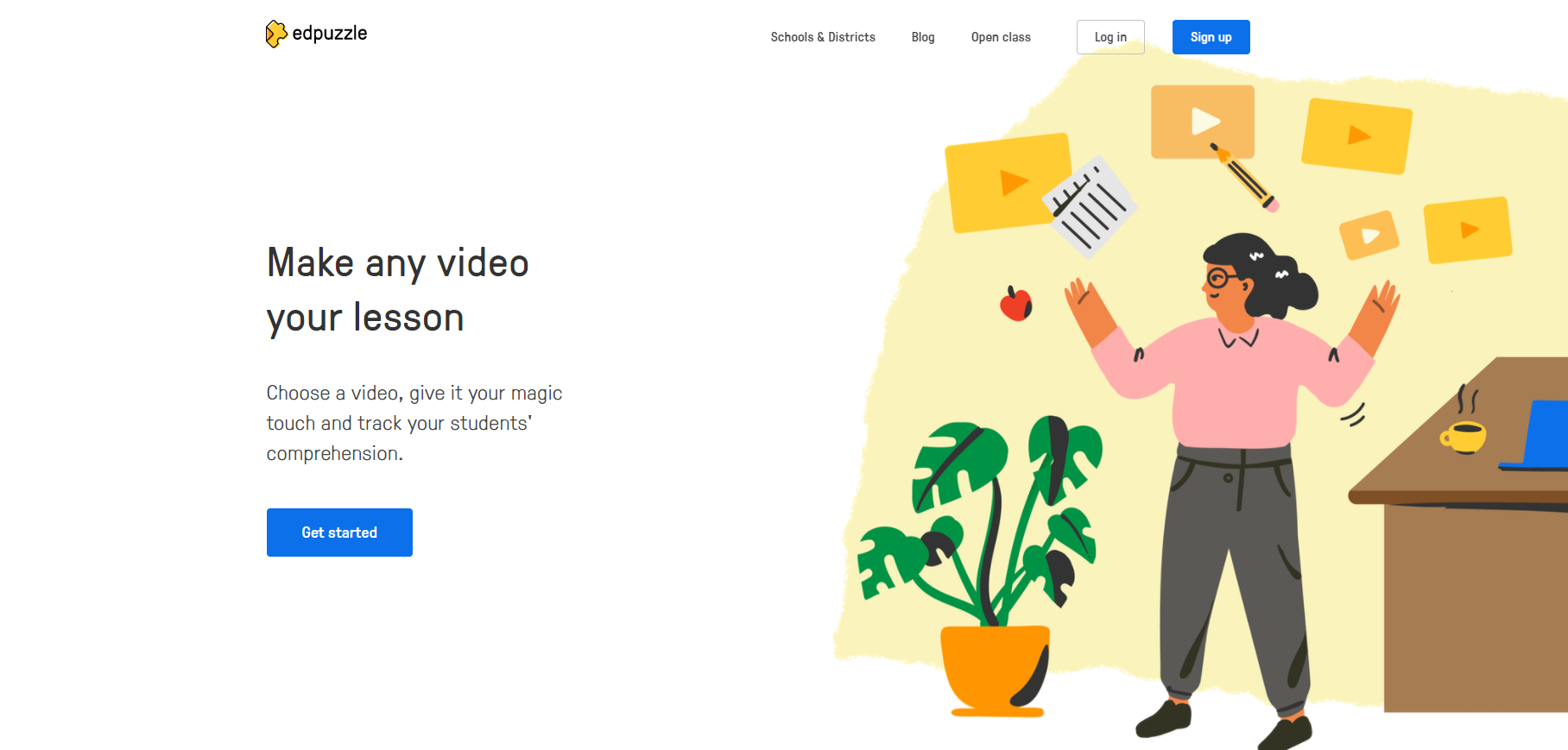“Technology will not replace great teachers, but technology in the hands of great teachers can be transformational.”
George Couros, Innovative Teaching, Learning, and Leadership Consultan
The flipped classroom approach is being increasingly adopted by teachers, backed by advancements in ed-tech and owing to the remarkable results it is showing.
According to a research, learners in a flipped classroom achieve better learning outcomes when the face-to-face class time is not reduced or when quizzes are added to the activity.
The study concludes that when designed appropriately, a flipped classroom can be a promising teaching approach.
Another study on flipping learning in the workplace shows that flipped classroom learning enables instructors to spend more time on higher-level learning and knowledge application rather than lectures.
Doing this also encourages creative problem-solving in employees.
Since this learning method is flexible, it empowers learners to decide what, where, and how they learn. It also removes the headache of having to teach all learners in a limited time frame.
If you want to implement this approach to set up your learning environment for success, then you’re at the right place. After reading this article, you’ll learn what a flipped classroom is, its benefits, how to implement a flipped classroom, and tools that you can use for the purpose.
Let’s get started.
Watch: How To Set up Your Virtual Classroom in 5 Minutes
What Is a Flipped Classroom?

(Source: tipsforfaculty)
A flipped classroom is a type of blended or hybrid learning that uses a combination of face-to-face and digital techniques. In the flipped classroom, what is “flipped” is the type of activities learners do in and out of class.
According to the Vanderbilt University Center for Teaching:
“The flipped classroom describes a reversal of traditional teaching where students gain first exposure to new materials outside of class, usually via reading or lecture videos. Then class time is used to do the harder work of assimilating that knowledge through strategies such as problem-solving, discussion, or debates.”
As you can see, the flipped classroom definition goes beyond just what activities are done when and where. What makes flipped learning so effective is the deeper meaning behind the various activities.
Learners can process information, identify their sticking points, and then ask questions during class. The ability to engage in strategies such as problem-solving, discussions, or debates also deepens learners’ engagement with the concepts to arrive at a real place of mastery, rather than just a superficial understanding.
History of Flipped Classrooms
The history of flipped classrooms began when two high school teachers in Colorado, Jonathan Bergman and Aaron Sams, began recording lectures and lessons in 2007, converting them into videos. They did this to help the learners who couldn’t attend classes catch up.
The two teachers, however, gave credit for the flipped classroom to a paper entitled “Inverting the Classroom” by Maureen Lage, Glenn Platt, and Michael Treglia in 2000.
After 2007, the concept of flipped classrooms started to take off when many schools began flipping their classrooms.
Around this time, Salman Khan, a financial analyst, began creating and posting short video tutorials on math for his nephew. These tutorials soon garnered large followings from students.
The rest is history.
Difference Between Flipped Classroom and Flipped Learning

Many people mistakenly believe that a flipped classroom and flipped learning are the same. There is a minor difference between the two, though.
A flipped classroom is the environment that facilitates flipped learning. Even though it makes all the factors for inverted learning available, it may not necessarily translate into flipped learning.
This leads us to flipped learning, which is what actually happens both inside and outside of a classroom. Flipped learning is learning that takes place at the individual level at their own pace.
Learners utilize the learning material provided by their instructors to learn at home while the classroom time is devoted to discussions and problem-solving with teachers and fellow learners.
In this sense, flipped classroom learning can be considered a better term to use to avoid confusion of any kind.
Things Learners Do At Home In A Flipped Classroom
Let’s now see what learners do at school or their workplace in a flipped classroom method.
Some of the activities learners get involved in at home in a flipped classroom setting are:
- Read physical or digital texts
- Review online course material
- Watch online video lectures
- Participate in online discussions
- Conduct research
Get Free eLearning Authoring Software — All Features, Forever.
We've helped 567 companies train 200,000+ employees. Create courses in under a minute with our AI LMS or use 200+ ready-made courses on compliance, harassment, DEI, onboarding, and more!
Things Learners Do At School/Workplace In A Flipped Classroom
Let’s now see what learners do at school or their workplace in a flipped classroom method.
- In-person discussion with peers/instructors
- Practicing a skill
- Peer reviews
Flipped Classroom Activities You Can Try

There are several flipped classroom activities that engage learners and make flipped classroom learning a success. Make sure you roll out these activities as soon as you implement a flipped classroom.
Active Learning
This is the key to a better learning experience, knowledge retention, and positive outcomes. Keep your learners actively engaged with educational or training material during class time. Let them engage in activities such as group discussions and role-plays.
This will put their creativity and problem-solving skills to the test.
Fishbowl Sessions
This type of group discussion helps develop interactive skills in learners through brainstorming. At the same time, it increases their comprehension by breaking down complex ideas into simple, easy-to-understand points.
Let some learners volunteer to bring up a topic for debate while others observe and note the different viewpoints presented.
Q&A Forums
Provide a platform where learners can engage in question & answer sessions through collaboration. This will help enrich the Q&A community members’ knowledge by clearing confusions and never leaving a good question unanswered.
Assessment
Evaluate your learners’ engagement level, course completion rate, course effectiveness, and other learning areas through regular assessments.
You can deploy a quiz, survey, or a simple test for this purpose. This exercise will keep you posted on where things stand as far as your flipped classroom learning is concerned.
Benefits of Flipped Classrooms
The flipped learning movement in the U.S. is still going strong even after more than 10 years it came into being. As an innovative and tech-driven way to learn, the flipped classroom model works for both instructors and learners. It proves to be more effective and engaging than traditional classrooms.
A flipped classroom brings several benefits, especially for learners. Here are some of them:
✅Better Learning
Many researchers have examined the results of flipped classroom learning, and so far, they are overwhelmingly positive.
One case study of flipped learning in a high school found that before the flip, more than 50% of first-year students had failed English and 44% failed math. After the school flipped its learning model, only 19% of first-year students had failed English and 13% failed math.
There were other positive results as well. For example, the number of discipline cases in a single semester decreased from 736 before the flip to 249 afterward.
✅Self-Paced Learning
In a traditional classroom, the instructor determines the pace of learning. This fails to serve most learners as some are fast learners while others are slow learners. Also, a single method of delivery may not work for all learners.
Unlike this, in a flipped classroom, learners can control the pace at which they learn. For example, they can stop, rewind, and review video lectures as many times as they need to until they understand the concepts. This is simply not possible when lectures are delivered live.
✅Room for More Interactions
Interaction is key to successful learning, and traditional, lecture-based classes offer very little opportunity for this essential component.
Fortunately, in a flipped classroom learning model, learners spend the entire class time interacting – with the content, with instructors, and fellow learners. They can ask questions, solve problems, and engage in activities that make learning meaningful.
Instructors can also spend more time on a one-on-one with their learners.
This is significant, particularly because learners who receive support from both their instructors and other learners do better academically and socially.
✅Reduction in Academic Disparities
In a traditional classroom, slow learners are often left behind or forced to move to the next level before they are ready. Over time, this can lead to great academic disparities in classes.
In a flipped classroom, since learners learn at their own pace, they all get equal opportunities to learn. Slow learners can take the time they need to master concepts.
✅Learning by Doing
In a lecture-based classroom, listening to lectures is the primary learning activity. This is passive, and the instructor often has no idea whether the learners are learning anything until test time.
In the flipped classroom learning, learners spend their class time on active learning. Not only is this a better way to learn, but instructors can gauge comprehension better and adjust the online training course content and schedule as necessary to ensure real learning takes place.
✅Mastery of Learning
In a traditional classroom, the emphasis is often on getting all learners to reach a minimum competency level. The goal is simply for learners not to fail, which means that even if a student receives a D in a course, that student will move to the next level.
On the other hand, flipped classroom learning is a more personalized form of learning that enables all learners to achieve mastery over different topics and subjects. Learners can continue working with a concept until they truly understand it, rather than just gaining a minimal understanding before having to move on.
Watch: How to Choose the Best Virtual Classroom Software
The Pros of a Flipped Classroom
There are two sides to a flipped classroom and you must be aware of them fully before you go for this learning method.
Pros
+ Control Over Learning: A flipped classroom gives learners more control over what, where, and how they learn. They can decide their learning pace as the learning is divided into two places – classroom and home.
+ More One-On-One Time: Since the class time is devoted to discussions, flipped classroom learning offers more one-on-one time with learners. It offers a highly interactive, two-way process.
+ Collaborative Learning: Learners can work together on common projects through classroom discussions and teamwork. They, thus, get benefits from the diversity of knowledge that each learner brings to the table.
+ More Efficient: Learners in the flipped classroom model report higher learning achievements and lower cognitive loads than those in the traditional classroom model. Clear-cut and engaging learning methods used in the system lead to greater efficiency.
Get Free eLearning Authoring Software — All Features, Forever.
We've helped 567 companies train 200,000+ employees. Create courses in under a minute with our AI LMS or use 200+ ready-made courses on compliance, harassment, DEI, onboarding, and more!
How to Create a Flipped Classroom
Wondering how to flip a classroom? It’s not that difficult.
With the kind of educational and training technologies available today, you can flip any classroom. All that instructors need to do is put their course material online for self-learning and facilitate collaborative learning in the classroom.
On the instructors’ side, you’d need a few online tools. See the following examples.
- Content creation tools – You can use different tools to create content for flipped classroom learning. You’ll need a learning management system (LMS) to create a course, a webcam for video lectures, screen share software for presentations and tutorials, and PDF software for text-based material.
If you can find a tool that takes care of each piece of content single-handedly, you will make your job a lot easier.
- Content distribution tools – After you’ve created the content, you need to distribute it.
There are many ways you can do this. One of the most popular is using a software program with an online course creator or authoring tool. These tools let you organize your course resources into modules that learners can log in and access.
They also provide additional tools, such as discussion forums and sometimes test-making software.
5 Best Software for Flipped Classroom
There are several tools that you can adopt to create and manage flipped classrooms. Here are five of them:
1. ProProfs Flipped Classroom Software

ProProfs is a simple and comprehensive cloud learning management system that you can use for different online learning environments.
Using this intuitive tool, instructors can easily create online courses, share them with learners, and provide access to eLearning modules and tests anytime and from anywhere.
Why choose ProProfs Flipped Classroom Software?
- A premium library of 100+ professionally designed and ready-to-use courses shortens the course development time. You can also create a course from scratch using its built-in authoring tool.
- You can also track learning progress in real-time and save time on grading by automating it.
- A centralized and secure virtual classroom software enables you to manage all these activities smoothly.
- The platform comes with an online Q&A forum for collaborative learning.
2. Khan Academy

Khan Academy is one of the top flipped classroom tools that provides short video lessons and practice exercises. Its mission is to change education for the better by offering a free and world-class learning experience to anyone, anywhere.
Why choose Khan Academy?
- Its trusted content library provides lessons on a wide range of subjects.
- Learners can engage in personalized learning based on their learning needs, while instructors can identify gaps in understanding and tailor instruction accordingly to meet the needs.
- The teacher dashboard provides detailed learner profiles and a summary of learners’ performance.
- Khan Academy supports translation into over 36 languages, including French, Spanish, and Brazilian Portuguese.
3. Edpuzzle

Edpuzzle is a provider of instructional video lessons and assessment tools, which are key components in flipped learning. You can add your voice narration and question to the videos and facilitate self-paced learning.
Why choose Edupuzzle?
- Learners can access eLearning content using any browser or operating system.
- One of the best parts about Edpuzzle is that you can record and upload your own educational videos. If you don’t have the bandwidth for that, you may use videos from YouTube, Crash Course, Khan Academy, and many other providers.
- Instructors can add a variety of formative assessments to their courses to evaluate learners during the learning process.
4. Google Classroom
It is another popular platform that instructors use to flip a classroom. You can use it to keep flipped classroom content organized in one place, give assignments to learners, and provide timely feedback.
Why choose Google Classroom?
- You can reuse the instructional material such as videos and presentations to teach different classes at different points in time.
- Whether you’re using the same content for all learners or following differentiated instruction to address different individual needs, Google Classroom makes it easy.
- Add to this the support the tool provides for sharing learning material with other Google products, including Drive, Sheets, and Docs.
5. Playposit

Playposit is an interactive video platform with more than 5 million learners. Its video editing tool allows instructors to add multiple-choice questions, fill-in-the-blanks, and other engaging tests to a video.
Why choose Playposit?
- You can track learners’ performance and behaviors to identify & bridge gaps and grade learners.
- Playposit integrates seamlessly with existing learning management systems and video hosting solutions.
- Besides catering to K-12 and higher education, Playposit’s interactive videos help improve corporate employees’ knowledge retention and productivity while ensuring customer satisfaction.
Reasons to Choose ProProfs
ProProfs is a simple and easy flipped classroom software that people use for both educational and corporate training programs. It offers all the essential solutions to help deliver learner-centric online learning. There are various reasons to make the tool your staple flipped classroom platform.
Easy to Use
ProProfs is the world’s easiest flipped learning system. Its clean, lean, and intuitive interface makes it easy to understand and navigate the tool. Even users with zero tech knowledge can use it.
Award-Winning
The tool has won many prestigious awards over the years, including for the best eLearning software and great user experience.
Trusted by Millions
ProProfs is used by more than 15 million users in over 150 countries.
Highly Secure
ProProfs regularly updates its software products with the latest security patches. It offers remote data backups. The tool is also GDPR-compliant.
Looking for Flipped Classroom Software? We Can Help!
The flipped classroom learning model works better than the traditional lecture-based model by allowing learners to learn at their own pace, providing active learning opportunities, and focusing on mastery rather than achieving the minimums.
In case you’re looking for a teaching and learning experience like this, we are here to help you with our complete flipped classroom software solutions.
ProProfs offers professionally designed online courses, tests, and videos that would come in handy in flipped classroom sessions. In addition, you get an online training platform that supports custom training with real-time tracking and reporting.
 Tips
Tips
We’d love to hear your tips & suggestions on this article!
Get Free eLearning Authoring Software — All Features, Forever.
We've helped 567 companies train 200,000+ employees. Create courses in under a minute with our AI LMS or use 200+ ready-made courses on compliance, harassment, DEI, onboarding, and more!

 We'd love your feedback!
We'd love your feedback! Thanks for your feedback!
Thanks for your feedback!







